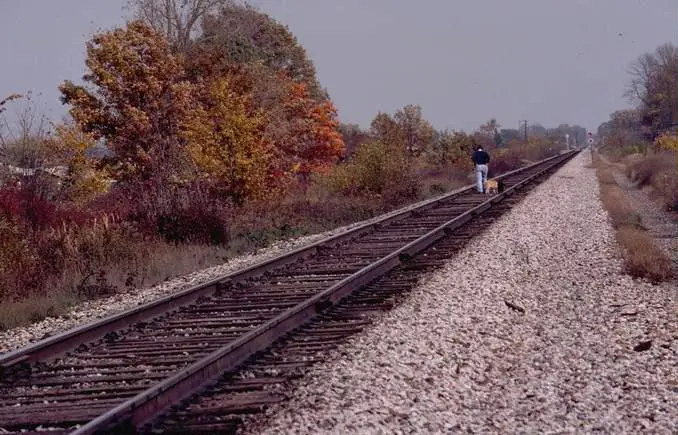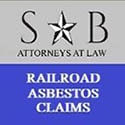
In the heart of our nation’s industrial past, thousands of railroad workers clocked in daily, unknowing participants in a silent epidemic. Asbestos, a once-commonplace material heralded for its heat resistance and insulation properties, became a hidden danger in the rail industry, leaving a legacy of health concerns for those exposed. Today, the legal team at Sammons & Berry, P.C., stands ready to champion the rights of retired railroad workers facing the aftermath of asbestos exposure.
The Unseen Hazard
For many years, asbestos was a staple in the railroad industry, used extensively in locomotives, brakes, and insulation. However, the microscopic fibers of asbestos pose severe health risks when inhaled, leading to conditions such as asbestosis, lung cancer, and mesothelioma. The impact of these diseases can take decades to manifest, often leaving victims unaware of the ticking time bomb within their bodies.
Asbestos Was Inhaled and Ingested by Railroad Employees
Asbestos, a mineral once ubiquitous in industrial and construction materials due to its heat-resistant and insulating properties, has left a dark legacy, especially among railroad employees. In the bustling environment of the railroad industry, workers were routinely exposed to this hazardous material, often without any awareness of the grave health risks. The inhalation and ingestion of asbestos fibers by railroad employees occurred through various means, creating a pervasive risk that has since led to serious, often fatal, health conditions.
The Ubiquity of Asbestos in the Railroad Industry
In the railroad sector, asbestos was extensively used in numerous applications due to its durability and resistance to fire and heat. It was commonly found in insulation materials for steam engines, boilers, and pipes, as well as in brake shoes and clutches. The material’s versatility made it a staple in the construction of railcars and locomotives, where it was used to insulate against the extreme heat generated by steam and friction.
Mechanisms of Asbestos Exposure
Inhalation of Asbestos Fibers
The primary route of asbestos exposure for railroad workers was through inhalation of airborne fibers. These tiny, invisible fibers were released into the air when asbestos-containing materials were disturbed during maintenance, repair, or demolition activities. Tasks such as replacing brake pads, cutting insulation, or grinding parts coated with asbestos materials could generate a significant amount of asbestos dust. Workers in the vicinity, often working in enclosed or poorly ventilated spaces such as engine rooms and undercarriages, would breathe in the contaminated air, allowing the fibers to lodge in their lungs and respiratory tract.
Ingestion of Asbestos Particles
While inhalation was the most common exposure route, ingestion of asbestos particles also posed a significant risk. Asbestos fibers could settle on the skin, clothing, hair, and personal belongings of the workers, and through activities such as eating or smoking without proper decontamination, fibers could be ingested. This secondary form of exposure was particularly insidious, as it allowed asbestos to enter the digestive system, where it could cause further internal damage.
The Role of Maintenance and Repair Work
Maintenance and repair activities were hotbeds for asbestos exposure. Workers involved in these tasks often had to handle old, friable asbestos materials that crumbled easily, releasing fibers into the air. The use of power tools and abrasive techniques exacerbated the release of fibers, increasing the concentration of asbestos in the immediate environment.
Secondary Exposure Through Clothing and Equipment
Asbestos contamination was not confined to the workplace. Workers unknowingly carried asbestos fibers home on their clothing, tools, and personal items, leading to secondary exposure among family members. This was particularly dangerous for spouses who handled the laundry, shaking out dusty work clothes and thereby releasing asbestos fibers into the home environment.
The Cumulative Effect of Asbestos Exposure
The insidious nature of asbestos-related diseases lies in their latency period; symptoms can take decades to manifest, making it difficult for workers to connect their ailments to past asbestos exposure. Continuous, long-term exposure compounded the risk, with each inhalation or ingestion of fibers contributing to the accumulation of damage in the body’s tissues.
Conclusion
The inhalation and ingestion of asbestos by railroad employees represent a tragic oversight in occupational health and safety practices of the past. The widespread use of asbestos in the railroad industry, coupled with the lack of protective measures and awareness, led to countless workers being exposed to this carcinogenic material. As these workers age, many are now facing the dire consequences of their exposure, battling severe, often fatal diseases that could have been prevented. It is a stark reminder of the importance of occupational health vigilance and the need for continued support and compensation for those affected.
A Beacon of Hope
Sammons & Berry, P.C., understands the depth of injustice faced by those who dedicated their lives to the railroads, only to be betrayed by the very environment they worked in. Our legal team specializes in railroad asbestos claims, offering a lifeline to those affected. With decades of experience, our attorneys have successfully navigated the complex landscape of asbestos litigation, securing the compensation that retired railroad workers rightfully deserve.
No Risk, Only Reward
We believe that justice should not come at a cost to the victim. Our firm operates on a contingency basis, meaning there are no upfront costs or financial risks to you. Compensation for your suffering is our top priority, and our fees are only collected if we secure a financial recovery on your behalf. With more than $30 billion set aside for asbestos victims, our goal is to ensure that you receive your fair share, simplifying the claim process without the need for lawsuits or court appearances.
Extending a Hand to Households
The repercussions of asbestos exposure extend beyond the workers to their families. Spouses of railroad employees may also be at risk, having unknowingly come into contact with asbestos fibers through clothing and household items. Sammons & Berry, P.C., recognizes the severity of secondary asbestos exposure and is committed to fighting for compensation for affected family members as well.
Your Next Steps
If you or a loved one worked in the railroad industry and are experiencing symptoms related to asbestos exposure, the time to act is now. Whether you’re a retired worker or a spouse bearing the brunt of secondary exposure, Sammons & Berry, P.C., is here to guide you through the process of filing an asbestos trust fund claim.
Begin your journey towards justice and compensation with a free consultation. Our dedicated team is ready to listen to your story, evaluate your case, and navigate the path to recovery together. Reach out to Sammons & Berry, P.C. today, and take the first step in reclaiming the peace and security you deserve.
Asbestos Trusts: Financial Assistance for Victims
In the wake of the widespread asbestos-related illnesses, various companies faced legal action, leading to the establishment of asbestos trusts. These trusts were designed to provide financial compensation to victims and their families affected by asbestos exposure. As of the latest available information, billions of dollars have been set aside in these trusts to assist those suffering from the devastating consequences of asbestos-related diseases.
The specific amount allocated to asbestos trusts is dynamic, as it depends on the number of claims and the financial status of each trust. As of my knowledge cutoff in January 2022, estimates suggest that the total amount across all asbestos trusts exceeds $30 billion. These trusts were established by companies that filed for bankruptcy due to asbestos-related liabilities, and they serve as a crucial lifeline for victims seeking compensation.
Starting Your Compensation Journey
Embarking on the journey towards compensation as a retired railroad worker on the East Coast is a pivotal step toward securing justice for the health risks you’ve endured. To initiate this process, we invite you to call our dedicated team at (800) 519-1440. Sammons & Berry, P.C. is poised to provide personalized assistance, ensuring that your case is handled with the utmost care and expertise. Your well-being and pursuit of justice are our top priorities.
Determining Your Eligibility for Compensation
Retired railroad workers on the East Coast may wonder if they qualify for compensation. The answer lies in understanding the specific circumstances of your asbestos exposure. Our legal team is well-versed in the criteria for eligibility and can assess your case thoroughly during the consultation. If you have concerns about your eligibility or simply wish to explore your options, our team is ready to provide the guidance and information you need.
Our commitment to retired railroad workers on the East Coast is not just a professional duty; it’s a promise to stand with you through every aspect of your compensation journey. From the initial consultation to the successful resolution of your claim, Sammons & Berry, P.C. is dedicated to ensuring that justice is served and that you receive the compensation you rightfully deserve.
See if you qualify for compensation
Sammons & Berry, P.C.
800-519-1440
View our Google Listing
View our Facebook


